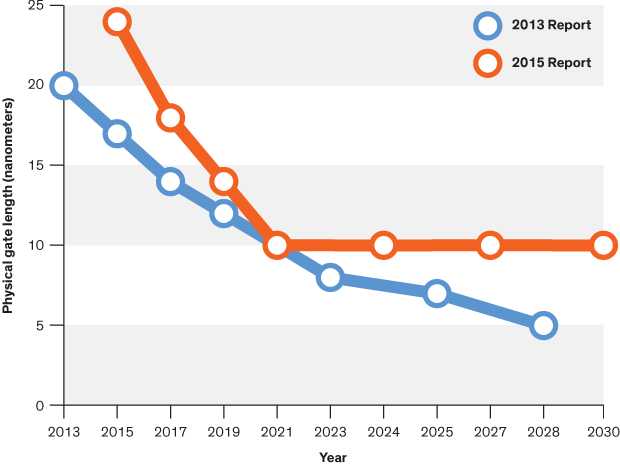Transistors Will Stop Shrinking in 2021, Moore’s Law Roadmap Predicts

The trajectory of transistor feature sizes (the physical gate length of
transistors in high-performance logic is shown here) could take a sharp
turn in 2021.
After more than 50 years of miniaturization, the transistor could stop shrinking in just five years. That is the prediction of the 2015 International Technology Roadmap for Semiconductors, which was officially released earlier this month.
After 2021, the report forecasts, it will no longer be economically desirable for companies to continue to shrink the dimensions of transistors in microprocessors. Instead, chip manufacturers will turn to other means of boosting density, namely turning the transistor from a horizontal to a vertical geometry and building multiple layers of circuitry, one on top of another.
For some, this change will likely be interpreted as another death knell for Moore’s Law, the repeated doubling of transistor densities that has given us the extraordinarily capable computers we have today. Compounding the drama is the fact that this is the last ITRS roadmap, the end to a more-than-20-year-old coordinated planning effort that began in the United States and was then expanded to include the rest of the world.
Citing waning industry participation and an interest in pursuing other initiatives, the Semiconductor Industry Association—a U.S. trade group that represents the interests of IBM, Intel, and other companies in Washington and a key ITRS sponsor—will do its own work, in collaboration with another industry group, the Semiconductor Research Corporation, to identify research priorities for government- and industry-sponsored programs. Other ITRS participants are expected to continue on with a new roadmapping effort under a new name, which will be conducted as part of an IEEE initiative called Rebooting Computing.
These roadmapping shifts may seem like trivial administrative changes. But “this is a major disruption, or earthquake, in the industry,” says analyst Dan Hutcheson, of the firm firm VLSI Research. U.S. semiconductor companies had reason to cooperate and identify common needs in the early 1990’s, at the outset of the roadmapping effort that eventually led to the ITRS’s creation in 1998. Suppliers had a hard time identifying what the semiconductor companies needed, he says, and it made sense for chip companies to collectively set priorities to make the most of limited R&D funding. ...MORE